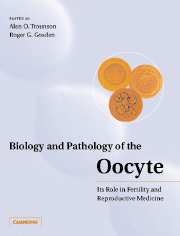Book contents
- Frontmatter
- Contents
- List of contributors
- Preface
- Part I Historical perspective
- Part II Life cycle
- Part III Developmental biology
- 6 Oocyte-specific gene expression: roles in folliculogenesis, fertilization and early development
- 7 Storage and functional recovery of molecules in oocytes
- 8 Endocrine regulation of meiosis - local and systemic hormonal influences
- 9 Checkpoint controls in mammalian oocytes
- 10 Fertilization: fate of sperm components after ICSI
- 11 Activation of the mammalian egg
- 12 Clinical applications in symmetry, asymmetry and polarity in early human development
- Part IV Pathology
- Part V Technology and clinical medicine
- Index
7 - Storage and functional recovery of molecules in oocytes
from Part III - Developmental biology
Published online by Cambridge University Press: 05 August 2016
- Frontmatter
- Contents
- List of contributors
- Preface
- Part I Historical perspective
- Part II Life cycle
- Part III Developmental biology
- 6 Oocyte-specific gene expression: roles in folliculogenesis, fertilization and early development
- 7 Storage and functional recovery of molecules in oocytes
- 8 Endocrine regulation of meiosis - local and systemic hormonal influences
- 9 Checkpoint controls in mammalian oocytes
- 10 Fertilization: fate of sperm components after ICSI
- 11 Activation of the mammalian egg
- 12 Clinical applications in symmetry, asymmetry and polarity in early human development
- Part IV Pathology
- Part V Technology and clinical medicine
- Index
Summary
Introduction
Fertilization in mammals brings together two transcriptionally silent genomes which have evolved separately during gametogenesis in the paternal and maternal organisms. The first developmental function of the embryo is to constitute its own unique and functional genome. This requires not only a transcriptionally active state but also the generation of a single chromatin structure able to regulate transcription, so that genes will be further expressed at the right time in the right cells. This involves first relieving the inhibitory chromatin structures that package and silence the gametic genomes, then remodelling the embryonic chromatin to organize it progressively, as in somatic cells, so that all epigenetic regulation levels of gene expression occur. These modifications of the chromatin structure, which differ between the maternal and the paternal genomes, require factors present in the oocyte cytoplasm. They require time and DNA replication and occur over several cell cycles, the number of which varies according to mammalian species.
Early development is thus a unique period in the life of an individual since it is governed by the genetic information synthesized from the genome of another individual (the mother) and stored during oogenesis as proteins or RNA in the cytoplasm of a single cell (the oocyte). Oogenesis itself is characterized by intense synthesis of RNA and proteins during oocyte growth, which can be stored for very long periods of time (months or even years). Such a long storage requires specific molecular processes: mRNAs have to be protected from the translational machinery and proteins have to be stored in nonfunctional forms. The recruitment of such information also requires specific mechanisms that are necessarily post-transcriptional for mRNAs and post-translational for proteins. These mechanisms allow specific molecules to be available at the right time. Oocyte maturation marks the onset of this maternal transcript and protein recruitment phase. It involves the progressive unmasking of maternal mRNA together with post-translational modifications of stored proteins. These recruitment processes relieve the stabilization mechanisms that were established during oogenesis. The maternal information is thus available to the developing embryo which will progressively take over this maternal inheritance. Such a maternal to embryonic transition in control of development (MET) has first been characterized functionally by the developmental arrest that occurs when embryonic transcription is inhibited.
- Type
- Chapter
- Information
- Biology and Pathology of the OocyteIts Role in Fertility and Reproductive Medicine, pp. 81 - 112Publisher: Cambridge University PressPrint publication year: 2003
- 16
- Cited by



